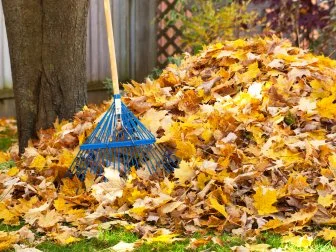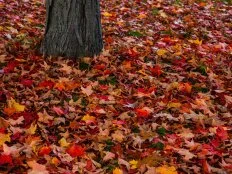Why You Should (and Shouldn't) Apply Fall Mulch
Find out the pros and cons of laying down mulch this fall.

Julie Martens Forney
When gardeners think of applying fall mulch, their thoughts typically turn to that extra layer that protects plants in cold regions from the ravages of a hard winter. But you can apply fall mulch just like you do in spring, adding enough to refresh what's broken down. Many landscaping professionals actually practice — and prefer — fall mulching. Fall mulch works like spring mulch to retain soil moisture, suppress weed growth and protect bare soil from erosion. But it also accomplishes a few more things:
- Fall mulch insulates soil, providing a warmer environment for the soil-food web, including earthworms and microbes. Warm soil means these organisms stay active longer into the cold season, improving your soil.
- Fall mulch insulates plant roots. In coldest regions, soil may eventually freeze solid in the heart of winter, but in many areas, soil cycles through freezing and thawing all winter long. Those freeze-thaw patterns put stress on anything in the top few inches of soil, including plant roots. Mulch moderates the temperature swing.
4 Reasons to Practice Fall Mulching
- Mulch in fall to skip that job come spring. Every gardener knows spring is a busy time, and late fall typically offers a leaner to-do list of garden chores. Fall mulching frees up time next spring.
- Cooler weather makes tackling a heavy job like mulching more pleasant. You work up less of sweat when air temps hover in the 50-degree range.
- Cut back perennials for winter, and you create a clean bed surface that makes mulching a snap. There's no dodging emerging bulbs, perennial shoots or seedlings. The bonus is that cutting perennial stems down in fall takes that chore off your spring to-do list.
- Fall mulching gives you another chance to enjoy the outdoors before winter weather ends your outdoor garden season.
Which Mulch is Best for Your Yard? 15 Photos
Find out what type of mulch is best for your yard and get tips on the best way to buy mulch.
4 Reasons to Skip Fall Mulching
- For best mulching results, you need to cut back perennial stems to 6- to 12-inch stubs so you can apply mulch evenly around them. Fall mulching isn't for you if you like to leave perennial stems to provide winter interest and insect or bird shelter.
- If self-sowers play a large role in your plantings, skip fall mulching. That fresh layer could interfere with seed germination in spring.
- The biggest challenge with fall mulch is that you need to squeeze the job in on weekends, especially in areas that practice daylight saving time.
- In regions where the snow starts flying early, you run the risk of having a snow-covered mulch pile if you don't get it all put out before winter arrives.
The Dos and Don’ts of Fall Mulch
- Do choose a mulch that traps air, much like down in a winter coat. Trapped air provides insulation and warmth. Good choices include shredded leaves, weed-free straw and shredded bark.
- Do aim to apply a 3-inch-thick mulch layer.
- Do choose the right mulch for the job: a formal, eye-pleasing mulch like shredded bark for front yard beds, pine straw for acid-loving azalea, rhododendron, holly, camellia, hydrangea and fothergilla, and informal straw or shredded leaves for vegetable gardens.
- Don't apply fall mulch too early. Wait until after the first hard freeze, so you can cut back perennials.
- Don't layer mulch deeply over perennial plant crowns (the growing points).
- Don't forget to anchor mulch in windy areas by covering it with wire fencing or chicken wire.
Learn More About Mulch
What Is Mulch and Which Mulch Should You Use?
Learn from HGTV's gardening experts about the types of mulch to use and where to use them in the garden.
10 Mulch Do's and Don’ts
Protect your plants and avoid top mulching mistakes by following these dos and don'ts.
Use Fall Leaves for Winter Mulch
Do yourself, your garden and your community a favor this fall. Reuse those leaves!
















































